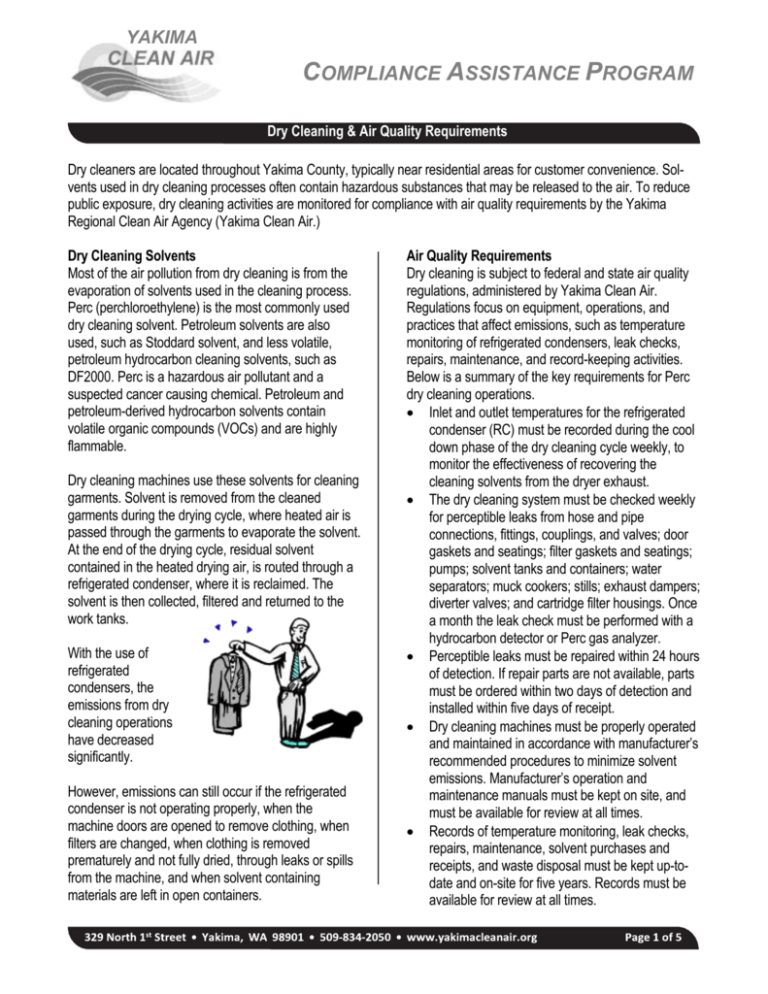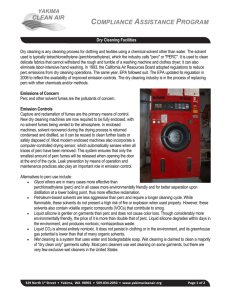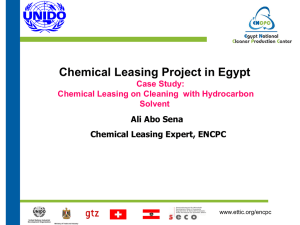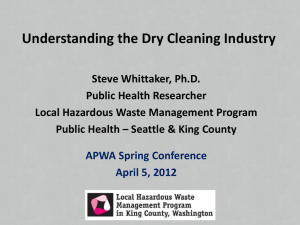NOV Fact Sheet - Yakima Regional Clean Air Agency
advertisement

YAKIMA COMPLIANCE ASSISTANCE PROGRAM Dry Cleaning & Air Quality Requirements Dry cleaners are located throughout Yakima County, typically near residential areas for customer convenience. Solvents used in dry cleaning processes often contain hazardous substances that may be released to the air. To reduce public exposure, dry cleaning activities are monitored for compliance with air quality requirements by the Yakima Regional Clean Air Agency (Yakima Clean Air.) Dry Cleaning Solvents Most of the air pollution from dry cleaning is from the evaporation of solvents used in the cleaning process. Perc (perchloroethylene) is the most commonly used dry cleaning solvent. Petroleum solvents are also used, such as Stoddard solvent, and less volatile, petroleum hydrocarbon cleaning solvents, such as DF2000. Perc is a hazardous air pollutant and a suspected cancer causing chemical. Petroleum and petroleum-derived hydrocarbon solvents contain volatile organic compounds (VOCs) and are highly flammable. Air Quality Requirements Dry cleaning is subject to federal and state air quality regulations, administered by Yakima Clean Air. Regulations focus on equipment, operations, and practices that affect emissions, such as temperature monitoring of refrigerated condensers, leak checks, repairs, maintenance, and record-keeping activities. Below is a summary of the key requirements for Perc dry cleaning operations. Inlet and outlet temperatures for the refrigerated condenser (RC) must be recorded during the cool down phase of the dry cleaning cycle weekly, to monitor the effectiveness of recovering the cleaning solvents from the dryer exhaust. The dry cleaning system must be checked weekly for perceptible leaks from hose and pipe connections, fittings, couplings, and valves; door gaskets and seatings; filter gaskets and seatings; pumps; solvent tanks and containers; water separators; muck cookers; stills; exhaust dampers; diverter valves; and cartridge filter housings. Once a month the leak check must be performed with a hydrocarbon detector or Perc gas analyzer. Perceptible leaks must be repaired within 24 hours of detection. If repair parts are not available, parts must be ordered within two days of detection and installed within five days of receipt. Dry cleaning machines must be properly operated and maintained in accordance with manufacturer’s recommended procedures to minimize solvent emissions. Manufacturer’s operation and maintenance manuals must be kept on site, and must be available for review at all times. Records of temperature monitoring, leak checks, repairs, maintenance, solvent purchases and receipts, and waste disposal must be kept up-todate and on-site for five years. Records must be available for review at all times. Dry cleaning machines use these solvents for cleaning garments. Solvent is removed from the cleaned garments during the drying cycle, where heated air is passed through the garments to evaporate the solvent. At the end of the drying cycle, residual solvent contained in the heated drying air, is routed through a refrigerated condenser, where it is reclaimed. The solvent is then collected, filtered and returned to the work tanks. With the use of refrigerated condensers, the emissions from dry cleaning operations have decreased significantly. However, emissions can still occur if the refrigerated condenser is not operating properly, when the machine doors are opened to remove clothing, when filters are changed, when clothing is removed prematurely and not fully dried, through leaks or spills from the machine, and when solvent containing materials are left in open containers. • • • YAKIMA COMPLIANCE ASSISTANCE PROGRAM Compliance Inspections During a typical on-site visit, inspectors will review: Operations Is the equipment properly maintained and operated according to the manufacturer’s recommendations? Are there any perceptible leaks with the dry cleaning machine, solvent and hazardous waste containers, the surrounding space and tools? Inspectors may use the senses of smell, sight, and touch, or a detector, to find perceptible leaks. If leaks are detected, have repairs been made within 24 hours of detection? If repair parts were not available, were parts ordered within two days of detection and installed within five days of receipt? Are Perc and related wastes are stored in closed containers with no perceptible leaks? Do monitored RC inlet and outlet temperatures indicate adequate condensation of solvents and removal from the exhaust vapor stream during the “cool down” cycle? Is the RC outlet temperature always 45º F (7º C) or less during the “cool down” cycle? Is the difference between the RC inlet and outlet temperatures 20º F (11º C) or more? Records Have weekly temperatures been recorded to demonstrate proper operation of the RC? Is a copy of the manufacturer’s operation and maintenance manual on site for review? Are waste manifests maintained? Are MSDS for cleaning solvents available on site? Are leak check records adequate? Have repairs occurred within 24 hours of detection? Are Perc receipts kept, including monthly and rolling 12-month totals? Other Your facility may have additional requirements you must comply with conditions of the New Source Review Order of Approval issued by Yakima Clean Air. Parts Per Million Typical Inhalation Response to Perchloroethylene 50 Odor threshold to un-acclimated persons 100 Faint odor definitely apparent to un-acclimated persons. 200 400 600 1,000 1,500 Moderate to faint odor upon exposure. Faint to moderate eye irritation. Minimal light-headedness. Eye irritation threshold – 100-200 ppm. Strong and unpleasant odor. Definite eye irritation, slight nose irritation. Definite lack of coordination (2 hours) of exposure at this limit. Strong odor, very unpleasant but tolerable. Definite eye and nose irritation. Dizziness, loss of inhibitions (10 minutes.) Very strong, intense, and irritating odor. Marked irritation to eyes and respiratory tract. Considerable dizziness, not likely to be tolerated voluntarily (2 minutes.) Almost intolerable odor, gagging. Intolerable irritation to eyes and nose. Complete lack of coordination in minutes to unconsciousness within 30 minutes. Going Beyond Compliance - Once a business has reached compliance, the next step is to look at going beyond compliance. As technology improves, new solvents and garment cleaning processes are being developed that have less environmental impact than Perc. Benefits may include reduced emissions, paperwork, and regulation requirements, as well as potential savings in hazardous waste disposal costs. Below are several “beyond compliance options” for Perc dry cleaners. Find what works best for your facility. • • • YAKIMA COMPLIANCE ASSISTANCE PROGRAM Type of Solvent or Process Hydrocarbon - a solvent (i.e. DF2000, EcoSolve) Benefits Concerns Most widely used solvent alternative, not Has regulatory requirements, machines high in toxicity, higher flash point than generally have nitrogen to prevent fire, traditional petroleum solvents, cleans longer cycle time, not as aggressive of delicates better than Perc, better feel than cleaner as Perc, bacteria growth in Perc, can retrofit some Perc machines for solvent must keep water in machine this solvent. clean, may not be able to retrofit all Perc machines to use this solvent. Tonsil - a special filter to put in Prevents bleeding of garments in Filter needs proper care or all benefits hydrocarbon machine (spin filter contains machine, can avoid distillation process, could be reversed, may have regulatory Tonsil and diatomaceous earth) don’t need to use detergent in machine, requirements. absorbs water eliminating bacteria growth problem. Pure Dry - a solvent variation of Same benefits as listed with hydrocarbon Same listed with hydrocarbon solvent, hydrocarbon with PFC and HFC solvent. regulatory and health concerns with the additives. D5 (decamethycyclopentasiloxane) - a Higher flash point than hydrocarbons, can Longer cycle time than Perc or solvent run in hydrocarbon machines, good on hydrocarbon, caused cancer in lab (i.e. Green Earth) delicates, good feel, currently no known animals. regulatory requirements. Glycol Ether - a solvent (i.e. Rynex, Very aggressive cleaner, no need to spot Cycle time is long, water separation is Solvair) clothes prior to cleaning. difficult, a VOC has some regulatory requirements, toxicity not clear, expensive equipment. Carbon Dioxide - a solvent (uses carbon Short cycle time, currently no known Special stainless steel and pressurized dioxide and detergent for cleaning) (i.e. environmental regulations. equipment required (~$120K vs. ~$40K Micell) for a Perc machine). n-PB (n-propyl bromide) - a solvent Solvent can be used in Perc machines, very aggressive cleaner Traditional Wet Cleaning - a process (use No known environmental regulations, water and detergent to clean garments) aggressive cleaning method. Icy Water - a process (similar to wet Same benefits as listed in wet cleaning, cleaning except garments are washed in lower agitation, can use traditional cold water and dried with cold air) finishing equipment, garments easy to finish. Green Jet - a process (spray water and Finishing much easier than wet cleaning, detergent rather than immersion) currently no known regulatory requirements • • • If solvent mixes with water it turns into acid and will harm garments, reproductive toxin, causes nerve damage, may be carcinogen, has some regulatory requirements. Need humidity controlled dryer and tensioning equipment. Need a washer with refrigerated condenser. Non-aggressive cleaning, may be better as supplementary technology. YAKIMA COMPLIANCE ASSISTANCE PROGRAM Alternatives to Spotting Another way to reduce emissions, protect employee health and save money is to change from traditional spotting chemicals to a Perc-free or TCE-free spotting agent. The Institute for Research and Technical Assistance performed field tests on spotting agents and found two safer alternatives: Cold Plus, and Nature’s Choice. The alternatives generally sold for $10-$20 less per gallon than traditional spotting agents. This is not an endorsement. Leak Detectors and Monitoring Equipment - New Federal Requirements On July 27, 2006, new federal requirements became effective for all dry cleaners that use the chemical perchloroethylene (Perc). Existing dry cleaning machines (installed between December 9, 1991 and December 21, 2005) must be in compliance with the new standards by July 28, 2008. One of the new rules requires dry cleaners to conduct monthly inspections for Perc vapor leaks using a halogenated hydrocarbon detector or Perc gas analyzer, such as a photo ionization detector. In the following tables is information on types of detectors that may meet EPA requirements. This is not an endorsement and is not an extensive list. Further research is recommended to find the best tool for your facility. Prices are subject to change. Sources: CARB, EPA and Tennessee Small Business Environmental Assistance Program. Perc Gas Analyzers - Photo Ionization Detector (PID) - Can be used for equipment leak detection (≥ 25 ppm Perc) and carbon adsorber monitoring (300 ppm ± 75 ppm perc / 100 ppm ± 25 ppm). Detectors are calibrated to be solvent specific. Price range $1,500 - $3,800. Manufacturer Model # Type Sensitivity Distributors Ion Science Americas LLC 1-800-224-5153 0.1-4,000 ppm info@ionscience-americas.com Ion Science PhoCheck 1000 PID 5% accuracy www.ionscience.com MiniRAE 2000 2 sensitivity levels Rae Systems ToxiRAE Plus 2 sensitivity levels PID PID International Sensor Technology IQ350-TLV- FALCON PID PID Analyzers / HNU DL-102 • PID • 0-99 ppm / 100-2,000 ppm 2% accuracy Rae Systems 206-310-5906 lstading@raesystems.com www.raesystems.com Inspector Tools 1-800-895-4916 0-99 ppm / www.inspectortools.com 100-2,000 ppm Cole-Parmer 2% accuracy 1-800-323-4340 www.coleparmer.com Low level (0-100 ppm) Medium International Sensor Technology level (0-500 ppm) 1-800-478-4271 www.intlsensor.com PID Analyzers, LLC 1-800-PID-6826 less than 1 ppm to 3.0 ppm www.hnu.com • YAKIMA COMPLIANCE ASSISTANCE PROGRAM Halogenated Hydrocarbon Detectors - Must detect 25 ppm or more Tetrachloroethylene (Perchloroethylene or Perchloroethene). Price range $125 $580. Manufacturer Model # Snap-On Inc. ACT 730 Leak Detector Halogen selective Inficon Inc. Aeroequal Semiconductor TIF Tek-Mate Type Sensitivity Heated Diode Halogen selective Aeroqual 200 Leak Detector Solvent specific (perchloroethylene) TIFXP-1A Six Tricolor LEDs for Visual Leak Indication, Halogen selective Se TIFRX-1A Six Single Color LEDs for Visual Leak Indication, Halogen selective Two Sensitivity Levels ven Sensitivity Levels TIFXL-1A One Sensitivity Level Non-selective • • <0.25 oz/yr Distributors Snap-on Equipment 1-800-225-5786 Clay.Cook@snapon.com http://buy1.snapon.com <0.4 oz/yr Nu-Way Products Co. Phillip Farmer 1-800-462-2089 www.inficonrefrigerantleakdetectors.com 0-200 ppm Kanomax USA, INC 1-800-247-8887 http://kanomax-usa.com/Aeroqual-Series200.html Grainger Industrial Supplies www.grainger.com <0.1 oz/yr <0.25 oz/yr <0.4 oz/yr • TIF 1-800-327-5060 www.tif.com Network Tool Warehouse Tel: 1-800-9398665 www.ntxtools.com Cleaner Supply 1-800-388-5410 www.cleanersupply.com







